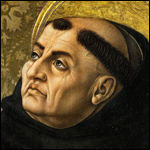What Did Thomas Aquinas Believe About Head Covering?

[Series introduction: This post is part of a series that examines what certain leaders in church history believed about head covering. Their arguments, choice of language and conclusions should not be misconstrued as an endorsement from us. The purpose of this series is to faithfully show what they believed about covering rather than only selectively quoting the parts we agree with.]

In the 1200’s Thomas Aquinas published a commentary on the book of Corinthians. It’s a thorough treatment that shows us how he understood head covering and how it was practiced in the middle ages.
To set the stage, Aquinas believed the focus of 1 Corinthians 11 was issues related to the Eucharist, and head covering related to proper dress during this practice. He said “[the Corinthians] erred in clothing, namely, because the women gathered for the sacred mysteries with heads uncovered”. So for Aquinas, head covering was a church issue.
He gave us two reasons to explain what it was that head covering symbolized. The first reason was “because a veil put on the head designates the power of another over the head of a person existing in the order of nature. The second reason he gave was, “to show that the glory of God should not be concealed but revealed; but man’s glory is to be concealed.” So head covering was a symbol that you were subject to another in nature and it was also meant to conceal the glory of man.
Since head covering is for when one “prays or prophesies” (1 Cor 11:4-5), let’s now take a look at how Aquinas defined those terms. He saw prophecy as when “man announces to others what has been divinely revealed to him” and when “he utters things which have been revealed to others; hence, those who read the prophecies or other sacred scriptures are said to be prophesying.” So prophecy was divine revelation and Scripture reading. For prayer, Aquinas saw it as public prayer, not that which is done privately. In his writing he deals with several objections to head covering that are based on contemporary situations where head covering doesn’t seem to be followed. He gives answers to all these objections by showing how they are not breaking the head covering command. One such issue was that some people in church did not pray with heads covered as they wished “to pray more secretly”. Aquinas says this type of secret prayer is not what Paul was referring to but that which “is public and is offered to God in the person of the entire Church”.
Other situational objections he dealt with were bishops who would teach (outside of church) with a miter on their heads. Aquinas responded that bishops only needed to uncover their heads when they recite “the Sacred Scripture in the church”. He also dealt with some who chanted psalms in choir uncovered and female nuns who had shaved heads. In every situation he explained how it did not contradict what was taught in 1 Corinthians 11 rather than saying what anyone did was wrong.
Speaking of shaved heads, Aquinas stated that “it is natural for a woman to have long hair”. He saw how women cared for their hair as evidence of this by saying, “a definite inclination is present in women to take care of their hair. For this is true in the majority of cases that women take more pains with their hair than men.” So woman is to have both “a natural and artificial covering” and if she was “deprived of an artificial covering” it would be dishonorable, just like if her head was shaved.
Another interesting point in his commentary is 1 Cor 11:10 where it says women are to cover “because of the angels”. Aquinas gives two options for interpreting this passage. One is to see the angels as angelic beings and head covering is a way to present ourselves “honorably and ordinately [in] reverence to them.” The second way is to see “angels” as referring to the priests of the church in which head covering would serve a dual purpose. The first would be “as reverence towards them” and the second “for their safety, lest the sight of a woman not veiled excite their concupiscence.” So head covering displays reverence and modesty.
The final verse regarding head covering (“we have no such custom, nor do the churches of God”) “silences the impudent hearers” according to Aquinas. It shut down all further debate regarding this practice to show that the churches were unified on this issue. Aquinas paraphrases this verse by saying “we Jews believing in Christ do not have such a practice, namely, of women praying with their heads uncovering, nor do the churches of God dispersed among the Gentiles. Hence if there were no reason, this alone should suffice, that no one should act against the common custom of the Church”.
All quotations can are from “Super I Epistolam B. Pauli ad Corinthios lectura” (translated into English by Fabian Larcher). It can be read online here.
- Is Head Covering Related to Spiritual Gifts? A Response to Barry York - July 5, 2023
- A Husband’s Authority is Limited (He is Not Pastor or King) - November 14, 2022
- Statement from Jeremy Gardiner: Leadership Transition - September 26, 2022



